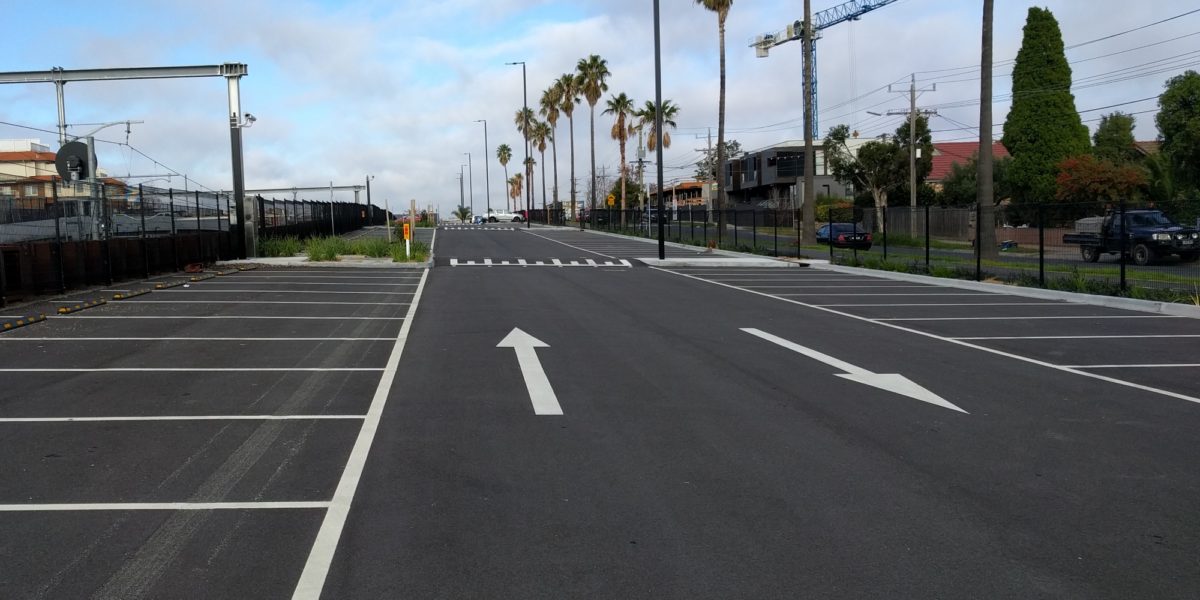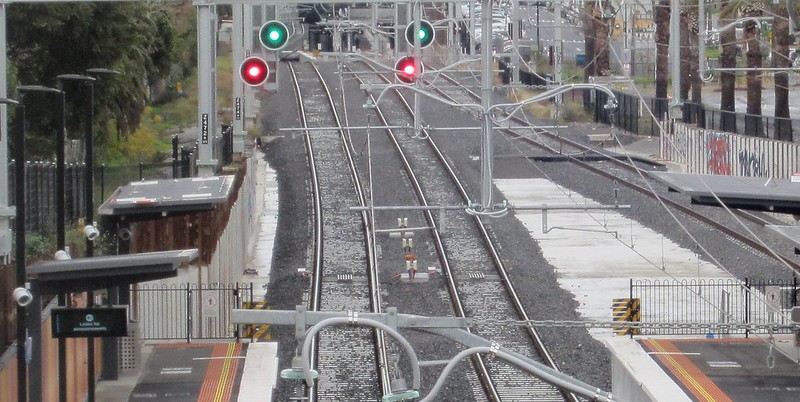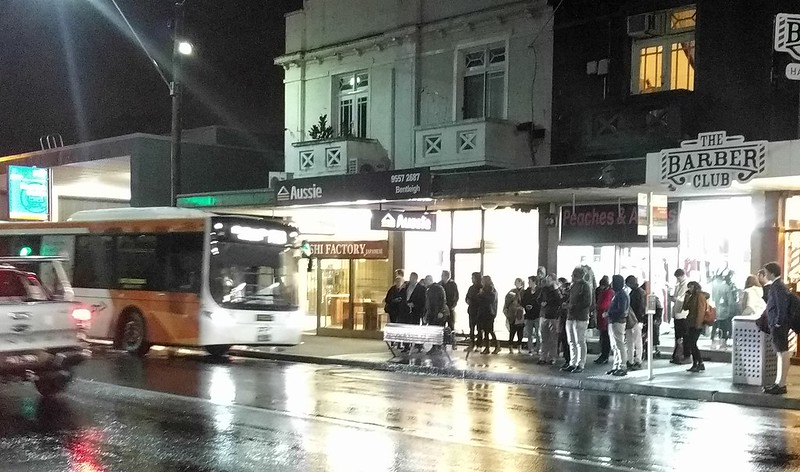The PTV web site reckons there are 298 car spaces in the car park at Clayton railway station.
Until recently the spaces were distributed around the station, some on the western side of Clayton Road, most on the eastern side, both sides of the railway line.
But with the new elevated “skyrail” line under construction on the north side, a number of spaces have been closed. To compensate for that, more spaces have been opened up on the southeast side of the station.
Here’s how it looks from the train when departing Clayton outbound:
Yes, the car spaces go all the way to Centre Road, some 750 metres from the station entrance.
This was filmed on a public holiday. Any locals care to comment how many of these spaces are filled on an average weekday? Are people really prepared to walk up to 750 metres from their car to catch a train? (I’m lucky enough that I only walk slightly further than this from home to the station.)
Bentleigh/McKinnon
At least at Clayton the car park only extends a fraction of the length to the next station. At Bentleigh, the car park now goes halfway to the next stop at McKinnon. It fills the entire space between Bentleigh station and the substation midway between the two stops.
In fact with the McKinnon platform extending south under the road, it doesn’t seem like too far from the end of the Bentleigh car park.
On weekdays, it appears the entire car park is used.
Unused most of the time
Station car parks, by their very nature, are near railway stations, which is also some of the most valuable, useful land in any suburb.
It’s also empty more than it’s full. From what I’ve seen, a typical suburban station car park might be only 20% full on weekends, and even emptier in the evenings. It’s probably only full between, at most, 7am and 6pm on weekdays — 11 hours per day, 77 hours out of 168 per week: 46% of the time. And in most cases the total is lower. Many car parks don’t fill up until later each morning.
Station car parks are also notoriously expensive to build, often costing $15,000 to $20,000 per space to construct. It’s an extraordinarily expensive way to get people onto trains, and it’s not scalable. Land is scarce. (And multi-storey carparks can easily multiply the cost per space by three.)
All this means these twentyish people catching a bus home from Bentleigh station have saved taxpayers almost half a million dollars in car spaces, as well as probably saving themselves thousands of dollars per year by avoiding running another car.
It’s not surprising that for those squeezed out of existing car parks think more and bigger car parks are the answer.
But ultimately the cost isn’t affordable, and it’s illogical to build a public transport system that requires people to drive to the stations.
More needs to be done to bring people to the station without their cars. Better walking and cycling facilities, better connecting buses and trams.
And you knew I was going to say that, didn’t you.



21 replies on “Station car parks: expensive, not scalable, and useful only 46% of the time”
It’s comical when the politicians cut the ribbon of a new Parkiteer bicycle cage that stores about 20 bikes. Melbourne currently has 218 train stations and they just opened the 100th Parkiteer cage. So not even half our train stations have a cage. If they were serious about getting value for money they would build infrastructure that accommodates at least 100’s of bikes. They can do it overseas so why not here? https://bicycledutch.wordpress.com/2014/07/03/utrechts-indoor-bicycle-parking-facility/
Other things being equal, I’d prefer a spot 700 metres from the station, than nowhere at all.
This is not new. My house is 850 metres from the station, and the area where the street is solidly parked out by commuters driving from 10 km away is now less than 50 metres from my house.
“… it’s illogical to build a public transport system that requires people to drive to the stations.”
Well you should tell the NSW Government that.
They are setting up a new bus route, where the stops are about 3 km apart, and they are closing some of the bus routes in the surrounding areas.
Their plan is that people will drive to bus stops, instead of walking to them.
And this argument that something is used 46% of the time, is pretty lame.
You probably only use your TV set 15% of the time ( in your case, probably less ), so you can get rid of that. And your dishwasher about 3% of the time, so you can get rid of that too. And your toilet, what, about 3% of the time. Get rid of it !
enno, that doesn’t make sense in the context of space that could be used for something else. There’s no point in just getting rid of something unless you are going to use the space it once occupied for something else.
If you got rid of your TV, what would you put in its place? A picture? A fish tank? Is that better than the TV?
Get rid of the dishwasher and what would you put where it once was? More cupboards? Do you need more cupboards? The dishwasher provides more value in that space.
The land near the stations could be used for housing or shops which would mean 100% use or a park which would be used by more people daily than the car park would (or a combination of these). If we put the same effort into making it easy to get to the station as we did building this car park we wouldn’t have to dedicate so much of our most valuable land to car parking.
And with the emergence of autonomous vehicles in the not too distant future, the whole concept and model of personal car ownership is likely to change and car parking may become a thing of history…..
Perhaps in 15-20 years, Clayton will have a lovely 800 metre long linear park running along the side of the railway??
Part of the reason for these massive car parks – Level Crossing Removal Authority’s “no net loss of car parking” policy:
https://wongm.com/2016/01/level-crossings-removals-and-car-parking/
We live in between Hughesdale and Oakleigh stations and have seen a massive increase in people parking in our street to walk to these stations (even before the current skyrail constructions). I don’t think the answer is more car parking, but then I live within walking distance of both stations. I just think it will take massive behaviour change to get people onto buses/walking further or cycling to all the way to stations – in addition to much better connected bus services. I guess I’ve formed that view because over the years I see so many people jump in the car for very short trips (i.e. to local schools very much less than 1k away). Over the 9 or so years I walked my kids to school (<750m) I was always being offered lifts home by my neighbours who just couldn't seem to understand why anyone would walk that far. And most didn't drive because they were continuing on to work – they were going straight home again. The bottom line is that many don't want to do anything other than drive and rarely try alternatives. (and they are probably not the people who read this blog)
As above regarding why people drive, its simply that driving is incentivised to the stations. The lack of pedestrian crossings or priority, bicycle routes which don’t join to the station, yet cars are given drive up access to as close as possible.
To get a parkiteer space requires a refundable payment and co-ordinating access in advance (and is limited in capacity) unlike parking which is simply free and first come first served.
It is amusing to walk or cycle from a station only to see people who were on the same train arrive to their house at the same time you do. The incremental costs of operating cars are just too low to discourage their use on financial issues alone, but suggestions of traffic calming in suburbs to increase active travel are politically unpopular. Instead the reverse happens and cars are given direct routes with priority at junctions and pedestrians are left with circuitous detours and waiting for gaps in traffic. Everyone on the train is a pedestrian, it shouldn’t be complicated to see that pedestrian access to stations should be the absolute priority.
A wider question is: Why don’t these people drive all the way to their destination rather than park at a train station?
For most, the answer is they would prefer to drive all the way, but due to (i) cost of parking in the city on workdays and (ii) awful traffic in peak times, it is cheaper and quicker to drive to the station and catch the train.
Hence, catching a bus would be doubly awful for them since they would rather not use public transport at all.
This has to be one of the silliest things I have ever read. A public transport advocate advocating against car parking at suburban railway stations.
Robert Jamieson, cycleways need to be built here.
There should be one from North Melbourne Station to Southern Cross Station and one from Jolimont to the MCG to Richmond station!
How hard is it?
Instead of relying on paint on the road – how does paint protect cyclists?
There should be a cycleway along the entire length of the regional rail link.
The new Cranbourne bus routes from November last year *still* don’t have real time info. Whether this makes much of a difference in the average commuter choosing to drive vs taking a bus I can’t say, but it certainly doesn’t help.
Let’s go controversial then… There should be a parking charge using a myki as the payment method at all station car parks. Anyone that wants to avoid the charge can then walk, bike or catch a bus or drive to work.
You say let’s have “better connecting buses”. Buses to connect with every train? Although my experience with connecting buses has only been occasional (but I’ve had some), at present, there seems no concept of the bus waiting for a delayed train (even if the bus schedule is supposed to align with the train times – and very often they don’t). And I don’t think anyone would suggest that the train should wait for a delayed bus (although, hopefully, the next train won’t be too far away).
Just the same, the idea of a parking charge, even if nominal, appeals – although won’t that increase pressure on surrounding streets?
If there is surplus railway land surrounding a station that is not being used for any other purpose, then surely provision of carparking to encourage more people to use the station is a positive thing.
The great thing about at-grade carparking is that it doesn’t cost that much to provide in relative terms if the land is already in Government ownership. It also doesn’t prevent the land from being used for other purposes in the future such as for providing additional track capacity or to realign tracks for grade separations. This would be significantly more difficult say if the land was sold off for development.
Also parking at railway stations is clearly popular with the voting public as evidenced by how full practically all the station carparks get on normal business days. With a few exceptions it is basically build it and they will come!
I’m no fan of driving to the stations, and think that the building of new stations should not even have parking as an important consideration (I do drive to the stations on weekends and public holidays, however, due to patchy bus services on those days).
However, I think arguing that station parking are under-utilised outside of the weekday working hours is a bit unfair and a possible double-edged sword. Some PT detractors and might turn the argument around and say that train services on the weekends should not be improved on accounts of how they are barely half-full other than during sportsball events and concerts.
On the argument of parking charges, I think at newly built stations, we could probably use the myki card as evidence of PT usage to raise those boom barriers on exit. We could charge those who have no evidence of PT usage for that day. However, is there really any significant evidence of people parking at stations where they are not interchanging with PT?
According to PTV’s data, there are just over 40,000 car parking spaces specifically allocated to train stations in metropolitan Melbourne. 509,701.92 square metres dedicated to car parking is a conservative estimate of the amount of space that this takes up: https://philam.github.io/trainstationcarparks/
Seems more than a little absurd.
Some good comments on this blog post and on Twitter, including that most public assets are used well below capacity most of the time. Which is true, though most of it doesn’t take up as much space as road-based infrastructure.
As @Dave (comment 5) says, it’s about the opportunity cost. What else could we do with that land?
@Alistair (comment 6) – interesting point. Would your car drive you to the station, drop you off then drive itself home again? What are the implications for congestion around transport nodes?
@Shaun (comment 11) – it’s about the most effective ways of getting people to stations. And you wouldn’t necessarily get rid of existing parking, nor would you rule it out where it’s appropriate. But is it appropriate in locations where better use can be made of that land?
@Nick (comment 13) – that’s interesting. I wonder if anybody has followed it up with PTV.
@gxh (comment 15) – getting properly co-ordinated services is quite difficult, especially when many of the most useful buses connect to multiple train lines. But it can be resolved by ensuring trains and buses/trams all run frequently. Wait times are reduced not just for single seat trips, but it also enhances the usefulness of the whole network.
Local streets around stations are already often time-restricted, whether there is parking at the station or not.
@Ross (comment 16) – the problem is that the cost is huge (above $15000 per space) even when the land is already available. And with attempts to increase housing density around stations, it’s still not good use for that land.
@Arfman (comment 17) – there have been issues with non-PT users parking in station car parks at some locations, typically local office or construction workers at places like Camberwell.
@Ross
Putting land to use is tempting, but green space is valuable (and useful as a noise barrier). Once the carparks are in they’re very hard to remove as people will base their routines and life decisions around the free infrastructure they use, ignoring that it is costing society to provide it. Peppercorn usage fees are a great way to incentivise change as we see with on street parking meters that charge far below the commercial operators in the same areas.
If carparks are going to be installed they need to be inclusive of pedestrian access, the headline image above shows a pedestrian hostile environment with fences that force pedestrians returning to their car to walk along the roadway of the carpark. Pedestrians are obliged by the road rules to give way to cars even in a carpark, and I’ve been honked at by cars that were simply blocked from moving a few meters forward to join a queue of stopped vehicles. Ground level carparks while cheap are out of proportion with the pedestrian environment, for instance adding a large footprint around shopping centres which then exclude pedestrian access.
My understanding is that Clayton car park you filmed is a “temporary offset car park”. I’m sure it will be used. Commuters park their cars on Huntingdale Road against the golf course from the station south to Davies Reserve, at least a distance of 750 metres.
As a commuter who walks to various stations (Westall, Clayton, Huntingdale, Oakleigh, Moorabbin, Bentleigh) for exercise and because I loathe driving to a station, it’s a fact that commuters will park their cars where they can if there is space for them.